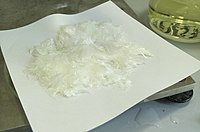
Photo from wikipedia
No single linear free energy relationship (LFER) exists that can predict reduction rate constants of all munition constituents (MCs). To address this knowledge gap, we measured the reduction rates of… Click to show full abstract
No single linear free energy relationship (LFER) exists that can predict reduction rate constants of all munition constituents (MCs). To address this knowledge gap, we measured the reduction rates of MCs and their surrogates including nitroaromatics [NACs; 2,4,6-trinitrotoluene (TNT), 2,4-dinitroanisole (DNAN), 2-amino-4,6-dinitrotoluene (2-A-DNT), 4-amino-2,6-dinitrotoluene (4-A-DNT), and 2,4-dinitrotoluene (DNT)], nitramines [hexahydro-1,3,5-trinitro-1,3,5-triazine (RDX) and nitroguanidine (NQ)], and azoles [3-nitro-1,2,4-triazol-5-one (NTO) and 3,4-dinitropyrazole (DNP)] by three dithionite-reduced quinones (lawsone, AQDS, and AQS). All MCs/NACs were reduced by the hydroquinones except NQ. Hydroquinone and MC speciations were varied by controlling pH, permitting the application of a speciation model to determine second-order rate constants (k) from observed pseudo-first-order rate constants. The intrinsic reactivity of MCs (oxidants) decreased upon deprotonation, while the opposite was true for hydroquinones (reductants). The rate constants spanned ∼6 orders of magnitude in the order NTO ≈ TNT > DNP > DNT ≈ DNAN ≈ 2-A-DNT > DNP- > 4-A-DNT > NTO- > RDX. LFERs developed using density functional theory-calculated electron transfer and hydrogen atom transfer energies and reported one-electron reduction potentials successfully predicted k, suggesting that these structurally diverse MCs/NACs are all reduced by hydroquinones through the same mechanism and rate-limiting step. These results increase the applicability of LFER models for predicting the fate and half-lives of MCs and related nitro compounds in reducing environments.
Journal Title: Environmental science & technology
Year Published: 2023
Link to full text (if available)
Share on Social Media: Sign Up to like & get
recommendations!